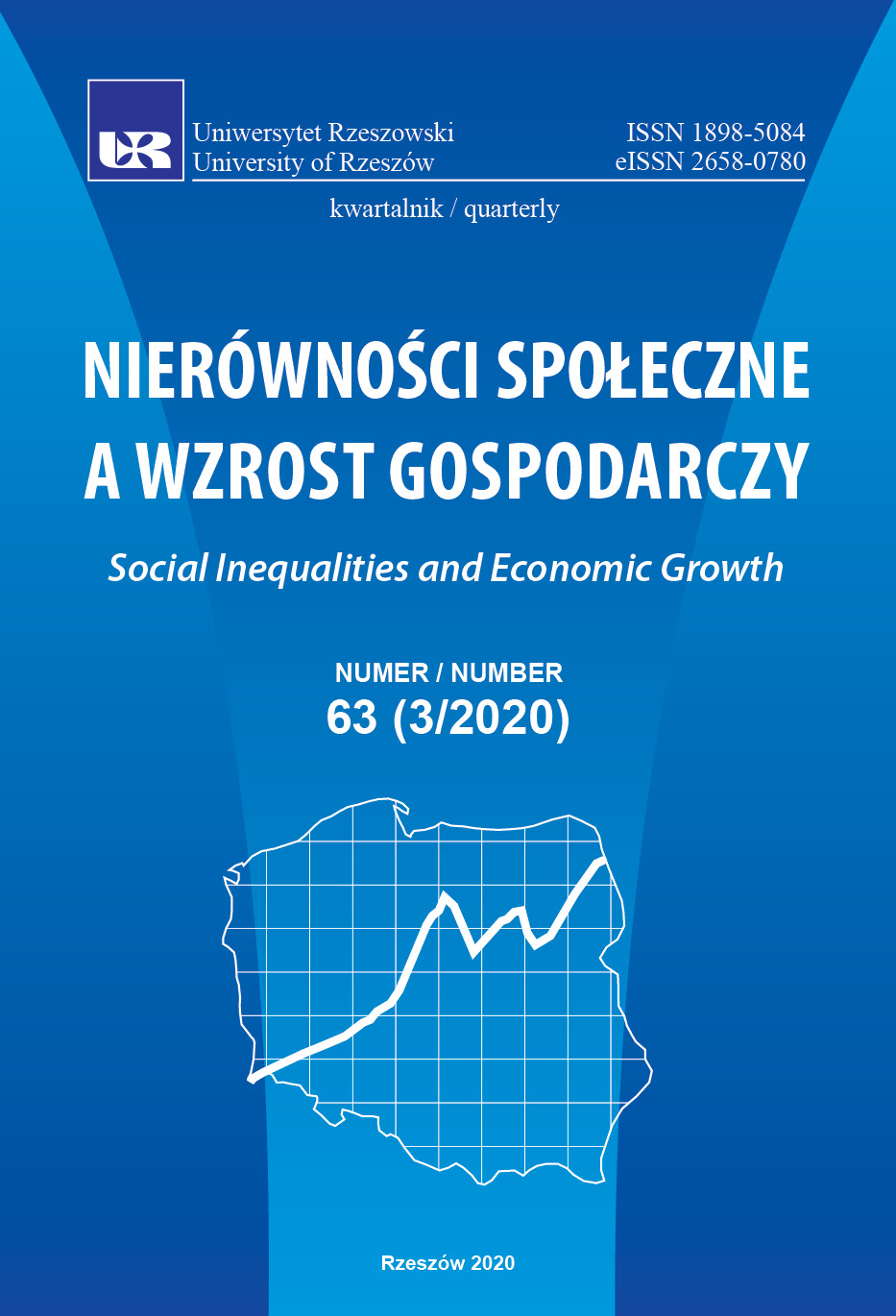The “Family 500+” programme and female labour force participation in Poland. Demographic and economic determinants
DOI:
https://doi.org/10.15584/nsawg.2020.3.2Keywords:
child cash benefits, female labour supply, “Family 500 ”Abstract
The paper investigates the effect of child cash benefit “Family 500+” on the female labour supply in Poland, taking into account demographic and cyclical determinants. The study is based on the Labour Force Survey (LFS) and Polish Central Statistical Office quarterly data. The analyses cover the period of 2016–2018. The Labour Force Participation Rate (LFPR) is the measure of labour supply. The analysis uses a counterfactual method to determine the impact of demographic and behavioural changes on female labour supply. To identify the causes of the economic inactivity of women (adopted by LFS), decomposition of the growth rate of economically inactive women is applied. The effect of the business cycle on female labour supply is analysed using OLS recursive regression. The study found that the LFPR of women aged 25–44 decreased after 2015. This was related to the cash transfers under the “Family 500+” programme and the increasing number of economically inactive women by reason of “family and household responsibilities”. At the same time, changes in the demographic structure contributed positively to the LFPR of women aged 25–44, while the business cycle did not have a significant impact on it. OLS recursive regression showed that in the 25–44 age group, the introduction of “Family 500+” coincided with changes in the relationships between the LFPR, the percentage of the “discouraged”, economically inactive women by reason of “family responsibilities” and the unemployment rate.
Downloads
References
Aaronson, S., Cajner, T., Fallick, B., Galbis-Reig, F., Smith, C.L., Wascher, W. (2014).
Labor Force Participation, Recent Developments and Future Prospects. Brooking Papers on Economic Activity, Fall, 197–275.
Aaronson, S., Fallick, B., Figura, A., Pingle, J., Wascher, W. (2006). The Recent Declinein the Labor Force Participation Rate and Its Implications for Potential Labor Supply. Brookings Papers on Economic Activity, 1, 69–154. DOI: 10.1353/eca.2006.0012.
Bastagli, F., Hagen-Zanker, J., Harman, L., Barca, V., Sturge, G., Schmidt, T., Pellerano, L. (2016). Cash transfers: what does the evidence say ? A rigorous review of programme impact and of the role of design and implementation features. ODI Report. London, Overseas Development Institute BISP ‘Homepage’. Webpage. BISP. Retrieved from: http://bisp.gov.pk (2020.02.13).
Bredtmann, J., Otten, S., Rulff, C. (2018). Husband’s Unemployment and Wife’s Labor Supply: The Added Worker Effect across Europe. Industrial and Labor Relations Review, 71(5), 1201–1231. DOI: 10.1177/0019793917739617.
Brzeziński, M., Najsztub, M. (2017). Wpływ programu „Rodzina 500 +” na dochody gospodarstw domowych, ubóstwo i nierówność. Retrieved from:http//coin.wne.uw.edu.pl/mbrzezinski/research/rodzina500plusPolitykaSpoleczna_nowa_wersja.pdf (2020.02.13)
CBOS (2017). Ocena programu „Rodzina 500 plus” po blisko roku od jego wprowadzenia. Komunikat z badań, 36.
Chrzanowska, M., Landmesser, J. (2018). Simulation of Ex Ante Effects of “Family 500+”Program. Prace Naukowe Uniwersytetu Ekonomicznego we Wrocławiu, 468, 38–46. DOI: 10.15611/pn.2017.468.04.
Connelly, R. (1992). The Effect of Child Care Costs on Married Women’s Labor Force Participation. The Review of Economics and Statistics, 74(1), 83–90. DOI: 10.2307/2109545.
Darby, J., Hart, R. A., Vecchi, M. (1998). Labour Force Participation and the Business Cycle: A Comparative Analysis of Europe, Japan and the United States. Retrieved from: https://ideas.repec.org/p/gla/glaewp/9802.html (2020.02.13).
Erceg, C. J., Levin, A. T. (2013). Labor Force Participation and Monetary Policy in the Wake of the Great Recession. IMF Working Paper, 245.
Fuchs, J., Weber, E. (2017). Long-term unemployment and labour force participation: a decomposition of unemployment to test for the discouragement and added worker hypotheses. Applied Economics, 49(60), 5971–5982. DOI: 10.1080/00036846.2017.1368991.
Gromada, A. (2018). Czemu służy program Rodzina 500 plus? Analiza celów polityki publicznej i polityki partyjnej. Ruch Prawniczy, Ekonomiczny i Socjologiczny, 80(3), 231–244. DOI: 10.14746/rpeis.2018.80.3.18.
GUS (2017). Dochody i warunki życia ludności Polski (raport z badania EU-SILC 2015 i 2016). GUS: Warszawa.
GUS (2018). Budżety gospodarstw domowych w 2017 r. GUS: Warszawa.
GUS (2019a). Sytuacja gospodarstw domowych w 2018 r. w świetle wyników badania budżetów gospodarstw domowych. Retrieved from: https://stat.gov.pl/obszary-te-matyczne/warunki-zycia/dochody-wydatki-i-warunki-zycia-ludnosci/sytuacja-gospodarstw-domowych-w-2019-r-w-swietle-badania-budzetow-gospodarstw-domowych,3,19.html (2019.05.30).
GUS (2019b). Zasięg ubóstwa ekonomicznego w Polsce w 2018 r. Retrieved from: https://stat.gov.pl/obszary-tematyczne/warunki-zycia/ubostwo-pomoc-spoleczna/zasieg-ubostwa-ekonomicznego-w-polsce-w-2019-roku,14,7.html (2019.06.28).
GUS (2007–2009). Biuletyn statystyczny GUS. GUS: Warszawa.
GUS (2015–2019). Mały rocznik statysytyczny Polski. GUS: Warszawa.
Hornstein, A. (2013). Why Labor Force Participation (Usually) Increases when Unemployment Declines. Economic Quarterly, 99(1), 1–23. Retrieved from: https://pdfs.semanticscholar.org/0005/4d5d4c27592e9f07e8c455dbaabc7b1d5471.pdf (2020.02.13)
Jaumotte, F. (2013). Female Labour Force Participation: Past Trends and Main Determinants in OECD Countries. SSRN Electronic Journal, 376. DOI:10.2139/ssrn.2344556.
Komunikaty Prezesa Głównego Urzędu Statystycznego w sprawie przeciętnego wynagrodzenia w gospodarce narodowej – 2016–2018.
Lee G. H. Y., Parasnis, J. (2014). Discouraged Workers in Developed Countries and Added Workers in Developing Countries? Unemployment Rate and Labour Force Participation. Monash University, Department of Economics, Discussion Paper, 15.
Magda, I., Kiełczewska, A., Brandt, N. (2018). The “Family 500+” Child Allowance and Female Labour Supply in Poland. IBS Working Paper, 1.
MRPiPS (2017). Minister Elżbieta Rafalska o szacunkach dotyczących „Rodzina 500 +”,5.07.2017. Retrieved from: https://archiwum.mpips.gov.pl/aktualnosci-wszystkie/rodzina-500-plus/art,8969,minister-elzbieta-rafalska-o-szacunkach-dot-rodzina-500. html (2020.02.13)
MRPiPS (2018). MRPiPS odpowiada: „500 plus” nie jest bezpośrednią przyczyną dezaktywizacji zawodowej kobiet. Gazeta Prawna, 20.03.2018. Retrieved from: https://serwisy.gazetaprawna.pl/praca-i-kariera/artykuly/1112265,500-plus-nie-jest-bezposrednia-przyczyna-dezaktywizacji-zawodowej-kobiet.html (2020.02.13).
Myck, M. (2016). Estimating Labour Supply Response to the Introduction of the “Family 500+” Programme. CenEA Working Paper Series, 1/16.
Ozerkek, Y. (2013). Unemployment and labor force participation: A panel cointegration analysis for European countries. Applied Econometrics and International Development, 13(1), 67–76.
Premik, F. (2017). Child support instruments and labor supply: evidence from a large scale child benefit program. NBP Working Paper, May 11, 1–28.
Rozporządzenia Rady Ministrów w sprawie wysokości minimalnego wynagrodzenia za pracę – 2016–2018.
Sánchez-Mangas, R., Sánchez-Marcos, V. (2008). Balancing family and work: The effect of cash benefits for working mothers. Labour Economics, 15(6), 1127–1142. DOI: 10.1016/j.labeco.2007.10.002.
Sobociński, M. (2016). Polska polityka rodzinna w latach 1989–2015. Próba podsumowania. INFOS, 8(212), 1–4.
Ustawa budżetowa na rok 2020. Uzasadnienie. (2019). Warszawa, wrzesień.
Van Zandweghe, W. (2012). Interpreting the recent decline in labor force participation. Federal Reserve Bank of Kansas City, first quarter, 5–34.
Downloads
Published
How to Cite
Issue
Section
License
Copyright (c) 2020 University of Rzeszow

This work is licensed under a Creative Commons Attribution-ShareAlike 4.0 International License.


